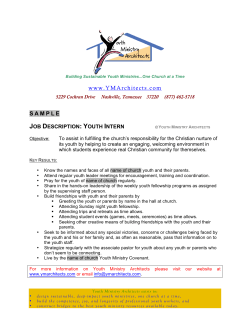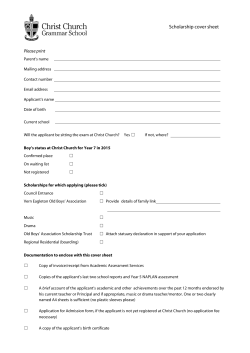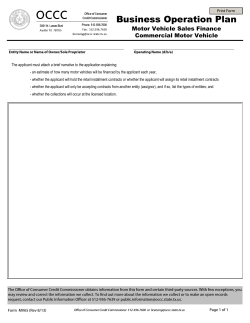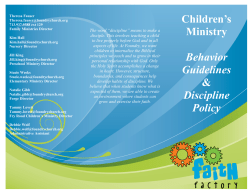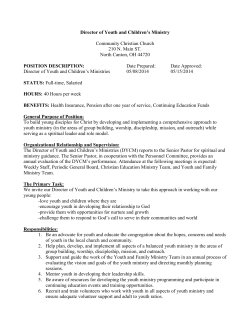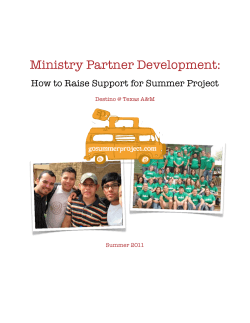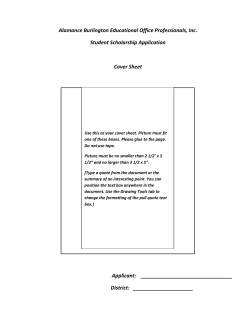
Adult Basic Education Student Assistance Program Policy and Procedures Manual
Adult Basic Education Student Assistance Program Policy and Procedures Manual Effective April 1 2014- March 31, 2015 Adult Basic Education Student Assistance Program Page 1 INTRODUCTION The Adult Basic Education Student Assistance Program (ABESAP) provides needs-based grants to learners enrolled in Developmental Programs. These grants are intended to off-set the costs associated with tuition, fees, books, unsubsidized childcare and transportation for learners most in need of financial assistance. Each year, 18 public post-secondary institutions delivering Developmental Programs receive a funding allocation from the Ministry of Advanced Education (The Ministry) to support the ABESAP program. These institutions then allocate funding directly to learners in accordance with defined policies and procedures. In 2011/12, government undertook a comprehensive review of the program, including an internal review of accountability and funding practices, as well as an external consultation with key stakeholder groups. This manual outlines the updated policies and procedures arising out of the review in the following areas: Student Eligibility Institution, Program and Course Eligibility Allowable Costs Funding Disbursements Administration and Reporting The Policy and Procedures Manual may be updated or amended by the Province, in its sole discretion, from time to time and will be posted by the Province. Contact Information: Louis Chen, Senior Policy Analyst Colleges and Skills Development, Ministry of Advanced Education (p) 250-387-6269 (e) Louis.Chen@gov.bc.ca Adult Basic Education Student Assistance Program Page 2 Table of Contents: Introduction page 2 Overview of Roles page 4 CHAPTER 1: Eligibility – Students Section 1: Immigration Status Section 2: Residency Requirement Section 3: Financial Need Assessment Section 4: Income Assistance Recipients Section 5: BC Student Loans Section 6: Withdrawal and Academic Progression Section 7: Reinstatement Section 8: Lifetime Maximum page 5 page 6 page 7 page 9 page 9 page 10 page 11 page 11 CHAPTER 2: Eligibility – Institutions, Programs and Courses Section 9: Eligible Institutions Section 10: Institutions and Partnership Agreements Section 11: Eligible Courses and Programs page 12 page 13 page 14 CHAPTER 3: Allowable Costs Section 12: Allowable Costs for Students Section 13: Allowable Costs for Institutions (administration fee) Section 14: Allowable Costs for Institutions (bulk book purchase) page 15 page 16 page 17 Chapter 4: Funding Disbursement Section 15: Government Disbursement to Institutions Section 16: Institutions Disbursement to Students page 18 page 19 Chapter 5: Administration and Reporting Section 17: Program Year Section 18: Reporting Requirements - Direct Learner Expenditures Section 19: Reporting Requirements - Eligible Programs/Courses Section 20: Reporting Requirements - T4A Section 21: Reporting Requirements - Bulk Book Purchase Section 22: Reporting Requirements - Administration Fee Section 23: Reporting Requirements - Exceeding Lifetime Maximum page 20 page 21 page 22 page 22 page 23 page 23 page 23 Appendix A: Adult Basic Education Student Assistance Program (ABESAP) Advisory Group: Kwantlen Polytechnic University Terms of Reference page 24 Appendix B: SAMPLE FUNDING TABLE used by Adult Basic Education Student Assistance Program (ABESAP) Advisory Group: Kwantlen Polytechnic University page 25 Adult Basic Education Student Assistance Program Page 3 Overview of Roles: The Ministry of Advanced Education will be responsible for the following: Ensuring funding to institutions is allocated in a timely manner Ensuring both Financial Aid Offices (FAO) and Developmental Program Administrators are made aware of allocations Reviewing reports submitted by institutions Engaging in dialogue with institutions regarding program and course eligibility Maintaining all documentation related to the program (application form, policy manual, electronic reporting system) and ensuring institutions are made aware of any changes to this documentation Post-secondary institutions will be responsible for the following: Ensuring students enrolled in, or planning to enrol in, developmental programs are aware of the ABESAP program and the process required to submit an application Processing ABESAP applications through the institution’s Student Financial Aid Office Engaging in a cross-institution decision-making process to ensure allocation of funding to students aligns with policy and institutional/provincial priorities Ensuring reporting requirements are met and funding is allocated in accordance with policies and procedures described in this manual Students will be responsible for the following: Signing and submitting an application for funding to their respective institution’s Financial Aid Office Providing documentation requested by Financial Aid Office (i.e. Proof of Immigration status) Adult Basic Education Student Assistance Program Page 4 CHAPTER 1: Eligibility - Students SECTION 1 Immigration Status POLICY In alignment with the Canada Student Financial Assistance Act, to be eligible for funding, an applicant must be a Canadian citizen within the meaning of the Citizenship Act or a permanent resident, or a protected person within the meaning of the Immigration and Refugee Protection Act. PURPOSE To ensure that students applying for assistance meet provincial immigration requirements. PROCEDURE Classification of students who are eligible for ABESAP. 1) Canadian citizens – these students will have a SIN starting with 1, 2, 3, 4, 5, 6 or 7. 2) Permanent residents – these students will also have a SIN starting with 1, 2, 3, 4, 5, 6, or 7, but are also required to provide their Permanent Resident Card or Record of Landing (IMM 1000) or Confirmation of Permanent Residence (IMM 5292 or IMM 5509). 3) Protected Person Status – these students may receive funding while they have a SIN starting with a 9. They must provide a copy of their SIN card showing an expiry date after their study end date, as well as a “Protected Person Status Document” or a “Decision Letter” issued by the Immigration Refugee Board (IRB). NOTE: Landed Immigrants with Investor Class Status NV5 are not eligible for ABESAP funding. The IMM 5521 is a Protected Person Status application, and must be specially requested from Citizenship and Immigration Canada. The following URL is the link to Citizenship and Immigration Canada http://www.cic.gc.ca. Successful applicants will be issued the “Protected Person Status Document”. Adult Basic Education Student Assistance Program Page 5 SECTION 2 Residency Requirement POLICY Students applying for ABESAP funds must be residents of British Columbia. PURPOSE To limit funding assistance to B.C. residents. PROCEDURE Students are considered residents of British Columbia for ABESAP funding if they fall into one of the three categories: a. you have lived in B.C. all your life; or b. B.C. is the province where you last lived for 12 continuous months, as of your study start date, not including months of full-time post-secondary study; or c. you arrived in B.C. as a permanent resident or landed immigrant, or protected person, and will attend school in B.C., and you have not lived in any other province for 12 continuous months. Adult Basic Education Student Assistance Program Page 6 SECTION 3 Financial Need Assessment POLICY Eligible students must demonstrate financial need. PURPOSE This program was established to assist students with a low income enrolled in developmental programs (see section: Program/Course eligibility for description of “developmental programs”). PROCEDURE Students must demonstrate financial need by completing an ABESAP application form. The application form must be completed in full, in ink, signed and dated. Each section of the form must be completed in full or identified as considered (e.g. N/A). The application form will be assessed by the institution’s FAO to determine the level of funding assistance awarded or declined. Use the following chart to determine if a student is deemed a ‘dependent’ or ‘independent’ applicant. Description Applicant is 22 and over Applicant is (irrespective of age): 1. A single parent 2. Married or in a common/aw relationship 3. A person with the ” Person with Disabilities” designation Applicant is under the age of 22 and does not reside with parent (s) Applicant is under the age of 22 and resides with parent (s) Independent vs. Dependent Independent Independent Demonstration of financial need An applicant’s income is based on line 150 of their tax return. If an applicant has not filed a tax return, financial need will be based on all sources of income from that previous year. An applicant’s income is based on line 150 of their tax return. If an applicant has not filed a tax return, financial need will be based on all sources of income from that previous year. If married or in a common-law relationship, the spousal income is considered. Independent Dependent An applicant’s income is based on line 150 of their tax return. If an applicant has not filed a tax return, financial need will be based on all sources of income from that previous year. Eligibility is based on combined parental income on line 150 of the tax return or all parental income from the previous year. Applicant is also required to provide income information. In the event that the applicant’s income is greater than the combined parental income, the student’s income is used and the applicant is considered a family of 1. Adult Basic Education Student Assistance Program Considerations Exceptions to chart A may be considered (at the discretion of the FAO) where the student and/or family income/assets were affected within the last 12 months by: 1. 2. 3. 4. Layoff or loss of employment. Unexpected reduction in income in the last 12 months (retirement does not qualify as an unforeseen circumstance). Strike or lockout. Medical illness/injury impacting employment income. A detailed rationale from both the student and/or parents (where applicable) must be submitted, stating the reason(s) why the originally assessed income or parental contribution should be reduced. Documentation to support these claims may be requested by the FAO Page 7 “Family Size”: For ‘independent’ applicants, family size is defined as the number of persons (including the student, spouse and dependants under the age of 19, or dependents over the age of 19 with special needs) within the student’s immediate family but excluding parents, siblings, and other relatives. For students deemed ‘dependent’ where the combined parental income is higher than the applicant’s income, the family size is based on the student’s immediate family INCLUDING parents and all dependents of the parent (i.e. other children under age of 19). For students deemed ‘dependent’ where the applicant’s income is higher than the combined parental income, the student’s income is used and applicant is considered a family of 1. “Gross Family Income” is defined as the amount of yearly income (line 150 of income tax return), and the full net value of assets, income from investments (including investments and property owned inside and outside of Canada), and monetary gifts. Chart A below indicates the gross family income level students must be under to be eligible for ABESAP funding. If the student’s gross family income exceeds the amount shown on Chart A, the student does not qualify for ABESAP funding. CHART A: Maximum Gross Family Income limits for ABESAP eligibility Family Size Income level 2014/15 1 $23,647 2 $29,439 3 $36,192 4 $43,941 5 $49,839 6 $56,209 7 or more $62,581 Adult Basic Education Student Assistance Program Page 8 SECTION 4 Income Assistance Recipients POLICY It is the responsibility of the learner to ensure that receiving ABESAP funding does not impact their income assistance eligibility. PURPOSE To ensure that students assume responsibility for ensuring that they adhere to policies established by agencies who are funding their living expenses. PROCEDURE Students are required to discuss this with their employment assistance worker as well as access the most up to date policies through the following URL: http://www.gov.bc.ca/meia/online_resource/verification_and_eligibility/students/ In the event that an income assistance recipient applies for ABESAP funding, any income assistance received by the learner should be counted toward their ‘gross income’. SECTION 5 Students Receiving Full-time Canada - BC Integrated Student Loans POLICY Learners accessing ABESAP while in receipt of a full-time Integrated Canada-BC student loan should do so only if they exceed 100% course load. PURPOSE The Ministry avoids disproportionately supporting learners enrolled in both developmental and post-secondary level programming. PROCEDURE Learners approved for full-time Canada-BC integrated student loans who are taking 100% course load and wish to take further developmental courses, are eligible for ABESAP funding support for these additional developmental courses (provided they meet other criteria). Learners approved for full-time Integrated Canada-BC student loans who are enrolled in less than 100% post-secondary course load and wish to enrol in developmental courses are not eligible for ABESAP funding until the point at which the learner is enrolled in excess of 100% course load. For example, a learner receiving a full-time integrated Canada-BC student loan who is enrolled in 80% course load (4 courses), would not be eligible for ABESAP funding to support an additional developmental course. It is assumed that since they are receiving a full-time student loan, that the difference between their actual tuition/books should be sufficient to cover the additional course. If this same learner were to enrol in 2 additional developmental courses (in excess of the existing 4 postsecondary courses), they would be eligible for ABESAP support for 1 of these courses as they would now be enrolled in what is calculated to be in excess of a ‘100% course load’. Adult Basic Education Student Assistance Program Page 9 SECTION 6 Withdrawal and Academic Progression POLICY Students who have previously received ABESAP funds and are applying for continued ABESAP funding must have demonstrated successful completion and/or satisfactory progress in their previous course(s). Students cannot receive ABESAP funding to support enrolment in the same course more than once. PURPOSE To ensure that ABESAP funding is limited to students who are pursuing their studies and progressing satisfactorily in their education in order to move into the workforce or pursue post-secondary training. PROCEDURE Students cannot access ABESAP funds to re-enroll in a course for which they have received ABESAP funds in the past. For example, a student cannot access funding twice to enroll in English 050, irrespective of their scholastic standing. Further, students who stop attending course(s), withdraw twice from course(s), and/or fail to demonstrate satisfactory progress in their education while funded by ABESAP will no longer qualify for future ABESAP funding from the Ministry for enrolment in any courses. Please refer to Section 7 for reinstatement policy and procedures. The FAO must endeavour to confirm that previous course(s) were successfully completed before approving assistance. However, it is understood that course registration generally occurs before previous course(s) are completed. Therefore, FAOs have the discretion to approve or conditionally approve funding for the next semester. In cases where students did not successfully complete previously funded course(s) and where extenuating circumstances occurred, approval for continued assistance is at the discretion of the FAO. An explanation and supporting documents must be kept with the application. In cases where a student obtained an unsuccessful grade or received an interim grade (i.e. student has not successfully mastered the course content but is making progress) and the instructor indicates that the student regularly attended classes, made progress on their previous attempt and requires more time to complete/pass the course, student can be approved for further funding. Approval for further funding is at the discretion of the FAO. The FAO may request the student provide documentation from the instructor regarding attendance and progress. Note: The intention of ABESAP is to provide funding to ensure students are progressing satisfactorily in their education in order to move into the workforce or pursue post-secondary training. FAO must use discretion when considering repeat funding to students. The instructor’s letter of support to the student is not, and should not be considered a “rubber stamp”. FAO should endeavour to obtain further clarification of the rationale of the instructor’s recommendation. FAO has the right to deny ABESAP funding despite the instructor’s recommendation. Please refer to Section 8 regarding “Lifetime Maximum”. Adult Basic Education Student Assistance Program Page 10 SECTION 7 Reinstatement POLICY Students funded by ABESAP, who have not shown academic progression on course(s) or are denied based on Section 6 may be reinstated for ABESAP funding if they successfully complete one semester (any number of courses), funded through their own resources. PURPOSE To ensure that ABESAP funding is limited to students who are earnestly pursuing their studies and progressing satisfactorily. PROCEDURE Students applying for reinstatement of ABESAP funds must demonstrate successful completion of one semester of studies (any number of courses), funded through their own resources. SECTION 8 Lifetime Maximum POLICY The lifetime maximum for ABESAP funding is 156 weeks. At the discretion of the FAO, this maximum can be extended. PURPOSE To ensure that ABESAP funding is limited to students who are upgrading or progressing satisfactorily in their education with the goal of entering into the workforce or pursuing post-secondary training. PROCEDURE A “funded” week is every full or partial week that the student has been funded for under ABESAP. The academic records of students receiving ABESAP funds are subject to review by the institution or Ministry after 156 weeks of funding. If a student withdraws, and does not credit back ABESAP, or fails to meet expectations of the course/program (see Section 6), or does not attend, this time is still considered “funded” weeks. If the student returns ABESAP funds after withdrawing, these weeks are deducted from the “funded” weeks used. If lifetime maximum is extended beyond 156 weeks, the institution must report by April 30 for this extension. Adult Basic Education Student Assistance Program th of each year the circumstances Page 11 CHAPTER 2: Institutions, Program and Course Eligibility SECTION 9 Eligible Institutions POLICY ABESAP assistance is available to students attending BC public post-secondary institutions that have been approved to administer ABESAP funding. PURPOSE To ensure that access to ABESAP funding is limited to institutions that meet the requirements for administering ABESAP. PROCEDURE The following institutions participate in ABESAP: British Columbia Institute of Technology Nicola Valley Institute of Technology Camosun College North Island College Capilano University Northern Lights College College of New Caledonia Northwest Community College College of the Rockies Okanagan College Douglas College Selkirk College Kwantlen Polytechnic University Thompson Rivers University Langara College University of the Fraser Valley Native Education College Vancouver Community College Vancouver Island University Adult Basic Education Student Assistance Program Page 12 SECTION 10 Institutions and Partnership Agreements POLICY ABESAP assistance is available to students attending developmental programs delivered through partnership agreements. PURPOSE To ensure that access to ABESAP funding is available to students attending community-based programs PROCEDURE Students who attend a developmental course or program (see Section 11 for description of program/course eligibility), delivered through a partnership agreement between a public post-secondary institution outlined in Section 9 and a private institution, community organization, or not-for-profit organization are eligible for ABESAP support if they meet the following criteria: 1. 2. 3. Are registered at the public post-secondary institution and issued a student ID number by that institution (see Section 9 for eligible institutions); Receive developmental course/program credit at the public post-secondary institution for their participation in the course/program delivered through the affiliation agreement; and, Meet all other Student Eligibility Criteria outlined in Sections 1-8 The FAO may request the student provide documentation from the instructor regarding the credit that will be received for participation in the course/program, confirm attendance, etc. Adult Basic Education Student Assistance Program Page 13 SECTION 11 Eligible Courses and Programs POLICY Developmental education courses/programs are eligible. These include Adult Basic Education, English as a Second Language, Adult Special Education, and Developmental ‘other’. PURPOSE To ensure that funding for direct educational costs are available to students with financial need enrolled in these programs. PROCEDURE FAO must ensure that ABESAP course(s)/program(s) be one of the following 4 course/program types (please note: these descriptions are for the purposes of ABESAP policy and are not intended to serve as program definitions): 1. Adult Basic Education: courses that are provided tuition free to the learner; or 2. English as a Second Language: courses that offer English language instruction at basic, intermediate or advanced levels to people whose first language is not English; or 3. Adult Special Education: courses at the adult basic education level available to individuals with permanent disabilities or combinations of learning difficulties; or, 4. Developmental ‘other’: courses at the adult basic education level that do not fit the criteria above and are not English Language Settlement Assistance programs, continuing education, personal interest/hobby, or ‘discovery programs’. Institutions are required to seek approval, prior to commencing funding, from the Ministry for the inclusion of any ‘developmental other’ course or program as ABESAP eligible. To do this, institutions are required to contact the Ministry via email (see contact information in introduction) to: demonstrate the rationale for the inclusion of the course/program, provide evidence of support from the Dean or Director of Developmental Education (or similar program coordinator) or Registrar; and, recognize that additional funding will not be provided for inclusion of the course/program There is no minimum program length or maximum program costs. Adult Basic Education Student Assistance Program Page 14 CHAPTER 3: Allowable Costs SECTION 12 Allowable Costs for Students POLICY Direct educational and targeted barrier costs for students demonstrating financial need and enrolled in eligible ABESAP course(s) may be considered for funding. PURPOSE To provide financial assistance for direct educational and targeted barrier-reducing costs to eligible students enrolled in ABESAP approved programs. PROCEDURE Allowable costs include: Tuition Fees - where applicable Fees - including compulsory and other non-discretionary fees (including UPass) Books - textbooks and course packs Supplies - standard course supplies including special clothing (hard hat, steel-toed boots, lab coat), calculators, criminal record check for work placement, etc, at FAO’s discretion Transportation Unsubsidized childcare Adult Basic Education Student Assistance Program Page 15 SECTION 13 Allowable Costs for Institutions (administration fee) POLICY An allowance of 8% of the allocated ABESAP funds may be used to cover administrative costs associated with ABESAP. PURPOSE To provide funds to assist with the administrative costs of ABESAP. PROCEDURE The institution is responsible for calculating the administrative allowance on ABESAP funds allocated during the program year (8% of funds expended for the current year – including those allocated to bulk book purchases). th The administrative allowance is to be reported via the electronic reporting system on April 30 of each year and shown as an expenditure of funds (see section 21). Adult Basic Education Student Assistance Program Page 16 SECTION 14 Allowable Costs for Institutions (bulk book purchase) POLICY Institutions may choose to recycle or bulk-purchase textbooks. PURPOSE To reduce the cost of textbooks purchased by the institution’s ABESAP budget and to increase the availability of funds to eligible students enrolled in ABESAP approved programs. PROCEDURE Recycling: Students purchase books initially with ABESAP funding and in subsequent semesters, these textbooks will be re-used. The FAO is responsible for developing a working system to facilitate this process. FAOs choosing this option can determine a service charge/handling fee to be charged by the institutional department managing this service. This fee should be minimal (e.g. $5.00 per transaction) and be used only for recycled textbooks. Bulk Purchasing: The FAO will determine the number of textbooks required in accordance with the number of students sponsored for ABESAP funding. The FAO is responsible for developing a working system and seeking approval from the Ministry for all bulk book purchases. The process for seeking approval: Contact the Ministry via email (see contact information in introduction) and outline: Bulk book purchase intention: including ISBN Evidence of support from Dean or Director of Developmental Education and/or designate Total cost A maximum of 35% of total ABESAP allocation made by the Ministry can be used for the purchase of textbooks using the bulk buying system. Additional exceptional expenses may be considered. The Ministry must approve these expenses in advance (i.e. bulk production of course manuals, bulk purchase of scientific calculators, etc.). Allow for 2-3 weeks for Ministry approval of a bulk book purchase. Adult Basic Education Student Assistance Program Page 17 CHAPTER 4: Funding Disbursement SECTION 15 Funding Disbursements - Government to Institutions POLICY Institutions will be notified of a notional allocation at the start of each fiscal year. The allocation is intended to be fully st st expended in the fiscal year (April 1 – March 31 ) it is received by the institution. The funding will be allocated across 3 payments. PURPOSE To allow institutions to adequately establish priorities for allocation of their ABESAP budget to students and to provide opportunity for the Ministry to align funding with student demand. PROCEDURE The Ministry will notify institutions of their funding level at the start of each fiscal year. A funding letter will be addressed to the institution’s president with a copy sent to the Financial Aid Office and the Dean or Director of Developmental education (note: if your institution does not have Dean or Director, it will be sent to a program level coordinator). Funding will be dispersed at intervals across the fiscal year and not in one lump sum payment. The Ministry may reallocate funding mid-year based on program demand. Early in the academic year, institutions will be asked to provide a program demand/financial forecast that will influence reallocation of funding for the remainder of the fiscal year. The policy manual will be updated to reflect any revisions to funding levels and procedures. Adult Basic Education Student Assistance Program Page 18 SECTION 16 Funding Disbursements – Institutions to Students POLICY Institutions are encouraged to engage in internal planning to establish priorities that will guide funding allocations to students. PURPOSE In the event that demand for ABESAP funds exceeds an institution’s actual ABESAP budget, the institution will benefit from establishing funding priorities to guide allocations. Further, this process will provide institutions the flexibility needed to ensure allocations are responsive to the unique circumstances of each institution (e.g., remoteness, program composition, etc.). PROCEDURE After receipt of ABESAP funds, the FAO will establish a process to engage various individuals across the institution (for example, developmental programs coordinators) to discuss the budget allocation from the Ministry, determine anticipated demand for funds, and establish funding priorities that will guide allocations. For example, this process may involve setting expenditure priorities such as reimbursing books prior to consideration of learners with transportation needs or it may consider the distribution of funds across program areas or campuses. Innovative planning practices are underway at a number of institutions, please refer to Appendix A for a description of the successful ABESAP planning process at Kwantlen Polytechnic University including a Terms of Reference for the institution’s ABESAP Advisory Committee. All priorities established will adhere to the ABESAP policies and procedures. Adult Basic Education Student Assistance Program Page 19 CHAPTER 5: Administration and Reporting SECTION 17 Program Year POLICY The ABESAP program year will run from April 1 to March 31. PURPOSE To align with the government and the post-secondary system fiscal year cycle. PROCEDURE st Funding will be allocated at the beginning of each fiscal and it is intended to be fully expended by March 31 of the following year. All reporting requirements for the program will follow the same fiscal cycle (see Section 18: Reporting Requirements). Any unused funds may be considered when determining the amount of the subsequent year’s allocation. Adult Basic Education Student Assistance Program Page 20 SECTION 18 Reporting Requirements –Direct Learner Expenditures POLICY Institutions are required to report ABESAP activity via the ABESAP Electronic Reporting System. This requirement is outlined in the Institutional Reporting Requirements list. PURPOSE Detailed information regarding institutional allocations and expenditures will assist government in demonstrating the positive impact of the program across participating institutions, as well as ensure that institutions are reporting consistently and allocating funding in accordance with the Policy and Procedures Manual. PROCEDURE st ABESAP reporting has been added to the list of Institutional Reporting Requirements and beginning April 1 , 2012 the Ministry requires the institution to indicate all ABESAP expenditures by learner, program type, and expenditure type on an ongoing basis using the ABESAP Electronic Database. Access to the site will require a BCeID. The URL will be sent directly to the FAO and instructions for reporting can be found on the site. The Ministry recognizes that a number of institutions have existing electronic record keeping practices. This electronic reporting system is not intended to ‘replace’ your existing system or result in dual data entry. The Ministry recognizes that there will be institutions that will engage in entry process on an ongoing basis and others that will engage in upload process at set intervals. In either event, the process is standardized and reporting is reviewed quarterly. For institutions uploading information from an existing reporting system, they will be required to update the electronic reporting system quarterly. Reporting will be done on or by the following dates: July 15th October 15th January 15th April 15th (including activity up to March 31st) Institutions that use the system for direct entry of information will not be required to upload their data as it is inputted on an ongoing basis. They are required to ensure it is up-to-date by the dates listed above. Please see Sections 19-23 for further reporting requirements (bulk book purchase, administration fee, courses and programs, and T4A). The fields for reporting include: 1. 2. 3. 4. 5. 6. 7. 8. Student ID number Immigration status Country of Citizenship Course Title Course Type (ABE, ESL, ASE, Dev Other) Course Code Start Date End Date 9. 10. 11. 12. 13. 14. 15. Tuition compensation Fees compensation (including UPass) Books compensation Transportation compensation Childcare compensation Other compensation Date of award NOTE: The Ministry has the authority to perform random audits at any time. Adult Basic Education Student Assistance Program Page 21 SECTION 19 Reporting Requirements – Eligible Programs/Courses POLICY Institutions will report all courses and programs that are deemed ‘ABESAP eligible’. PURPOSE To ensure funding is being targeted to support learners in ‘developmental programs’. PROCEDURE The institution will be responsible for reviewing and updating their course/program list by October 15 of the program year. This will be done via the electronic reporting system (see section 18). Please see section 11 for eligible program/course types and the process for seeking approval of adding a ‘developmental other’ course to your list of eligible courses/programs. SECTION 20 Reporting Requirements – T4A POLICY The institution is responsible for issuing T4As to students in receipt of ABESAP funds for combined yearly award amounts totaling more than $499 (calendar year). PURPOSE To ensure adherence to tax regulations. PROCEDURE Institutions will provide written confirmation that they have issued T4As to students accordingly. Details of actual T4As should be omitted. th This letter will be required by April 30 of each program year and should be uploaded to the electronic reporting system by this date. The letter should be addressed to the Ministry and signed by a spending authority at the institution. Adult Basic Education Student Assistance Program Page 22 SECTION 21 Reporting Requirements –Bulk Book Purchase POLICY The institution is responsible for reporting bulk book purchase expenditures. PURPOSE To ensure percent of funding allocated to bulk book purchase does not exceed 35% of the funding allocated by the Ministry. PROCEDURE Institutions will update the electronic reporting system when any bulk book purchases are made. As noted in section 14, all bulk book purchases require Ministry approval. SECTION 22 Reporting Requirements –Administration Fee POLICY The institution will report administration fee annually. PURPOSE To ensure institutions stay within the 8% administration fee policy. PROCEDURE th Institutions are required, by April 30 of each program year, to provide the exact administration fee expenditure via the electronic reporting system. SECTION 23 Reporting Requirements – Exceeding Lifetime Maximum Allocation POLICY Institutions that provide more than 156 weeks of ABESAP support to a student are required to outline the exceptional circumstances for this extension. PURPOSE To ensure equitable access to funding for learners. PROCEDURE th Institutions are required, by April 30 of each program year, to provide the exceptional circumstances that warranted an extension to the 156 week lifetime maximum policy. This can be done via the electronic reporting system. Adult Basic Education Student Assistance Program Page 23 APPENDIX A: Adult Basic Education Student Assistance Program (ABESAP) Advisory Group: Kwantlen Polytechnic University Terms of Reference COMMITTEE OVERVIEW The Adult Basic Education Student Assistance Program (ABESAP) Advisory Group provides recommendations on how funding, received by the Ministry of Advanced Education, should be best allocated as it relates to the program and its sub-categories (e.g. Adult Basic Education, University Qualifying Studies, English Language Studies, Access Programs for People with Disabilities, and Career Choices and Life Success). Guidelines and procedures related to both allocation and disbursements will be established in support of the Institution’s admission, enrolment and retention goals, while adhering to the governing policies set out by the Ministry of Advanced Education. DUTIES 1. To develop and implement appropriate recommendations, in conjunction with administrative policies, regulations and procedures, with regard to the allocation of funding and disbursements for the program. 2. To provide recommendations on criteria for the allocation of all financial resources. 3. To develop strategies to ensure the Institution’s community is informed of the funding available, the selection criteria employed, and application procedures. 4. To conduct a yearly evaluation of the selection process and criteria. 5. To make recommendations for the development of new funding resources of financial assistance, where necessary. 6. To establish a sub-committee of the Advisory Group to make nominations for particular allocations and/or disbursements, as required. ADVISORY TO: Senior administrator (e.g. VP Academic and/or VP Strategic Enrolment Management) SUGGESTED COMMITTEE MEMBERSHIP Senior Financial Aid Officer Dean (or representative) from the Faculty where ABESAP resides (e.g. Academic and Career Advancement) Instructor, ELST Instructor, ASE Instructor, ABE Instructor, ABE – Continuous Intake CHAIRPERSON The senior Financial Aid Officer will chair the Advisory Group. MEETINGS Meetings shall normally be held once per semester. The Chair may convene meetings as necessary for the efficient performance of the Advisory Group. All recommendations will be submitted by the Chairperson to their senior administrator (e.g. VP, Academic) for final consultation and approval. Adult Basic Education Student Assistance Program Page 24 APPENDIX B: SAMPLE FUNDING TABLE used by Adult Basic Education Student Assistance Program (ABESAP) Advisory Group: Kwantlen Polytechnic University Funding Allocation for 2011/12 Less 8% Admin Fee Funds Availaibe for Disbursement ESTIMATED FEES CALCULATION (based on 9 credits) Value A Value B Value C ESL Tuition + Anc Med/Den Multi-Pass Percentage of funds disbursed each semester (based on 2010/11 Fiscal Year Statistics) X Y Z $ Summer Fall Spring 201020 201030 201110 25% of Value C 35% of Value C 40% of Value C Value D Value E Value F Value C ABE Ancillary Med/Den Multi-Pass Percentage of funds disbursed by program each semester (based on ABESAP Final Report to Ministry for 2010/11) ESL ABE ASE - X Y Z $ - ASE Flat fee Med/Den Multi-Pass 51% 44% 5% X Y Z $ Proposed Summer 201120 Disbursements No ABE textbooks purchased) Value D x 51% ESL Value D x 44% ABE Value D x 5% ASE Value G Value H Value I Value D - Students awarded Value J Value K Value L Value E - Students awarded Value M Value N Value O Value F - Students awarded - Students awarded - Proposed Fall 201130 Disbursements (ABE Textbooks) = Value E x 51% Value E x 44% Value E x 5% ESL ABE ASE Proposed Spring 201210 Disbursements (ABE Textbooks) = Value F x 51% Value F x 44% Value F x 5% ESL ABE ASE Sub Total ESL Sub Total ABE Sub Total ASE GRAND TOTAL Adult Basic Education Student Assistance Program Value G + J + M Value H + K + N Value I + L + O Page 25
© Copyright 2025
